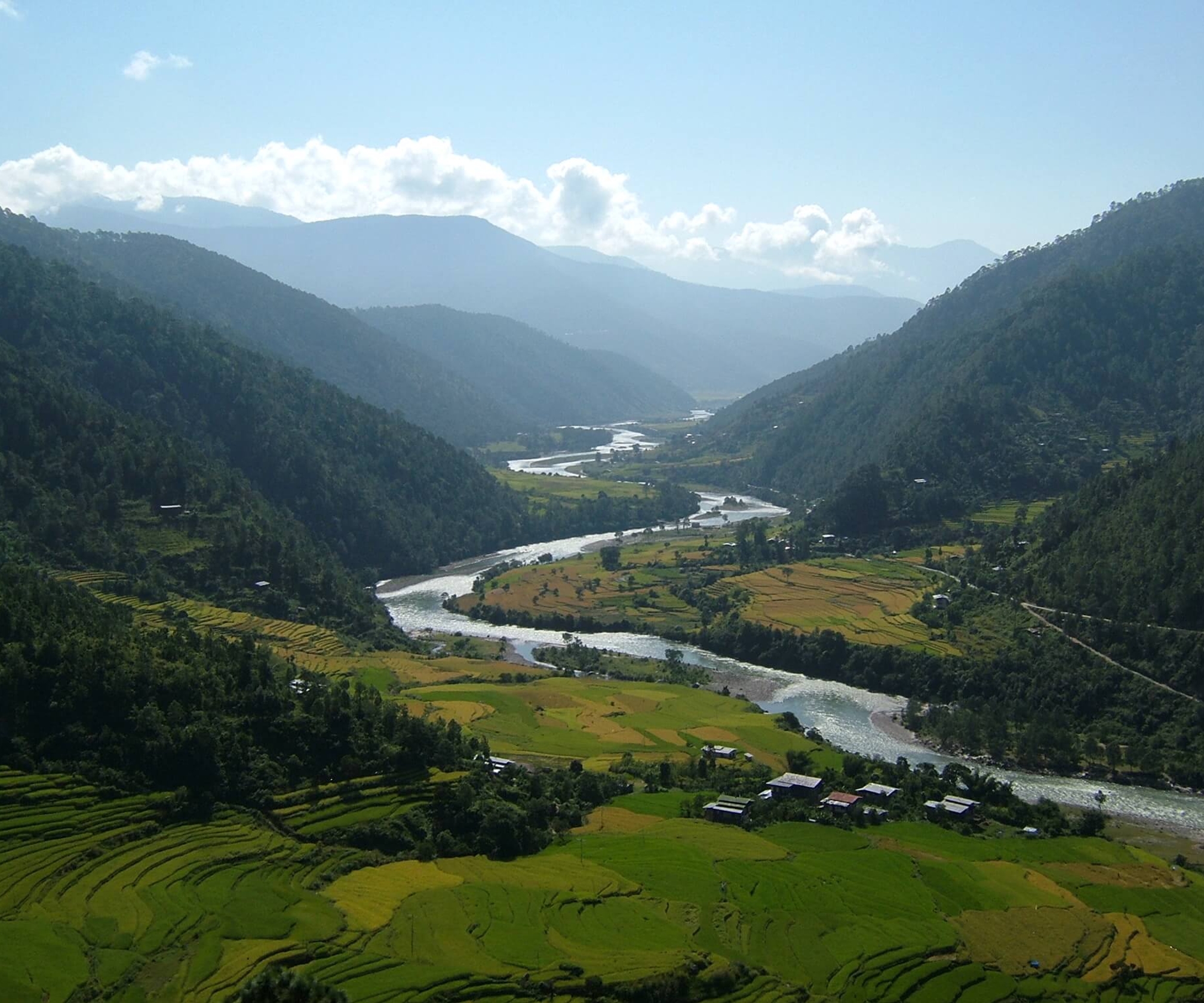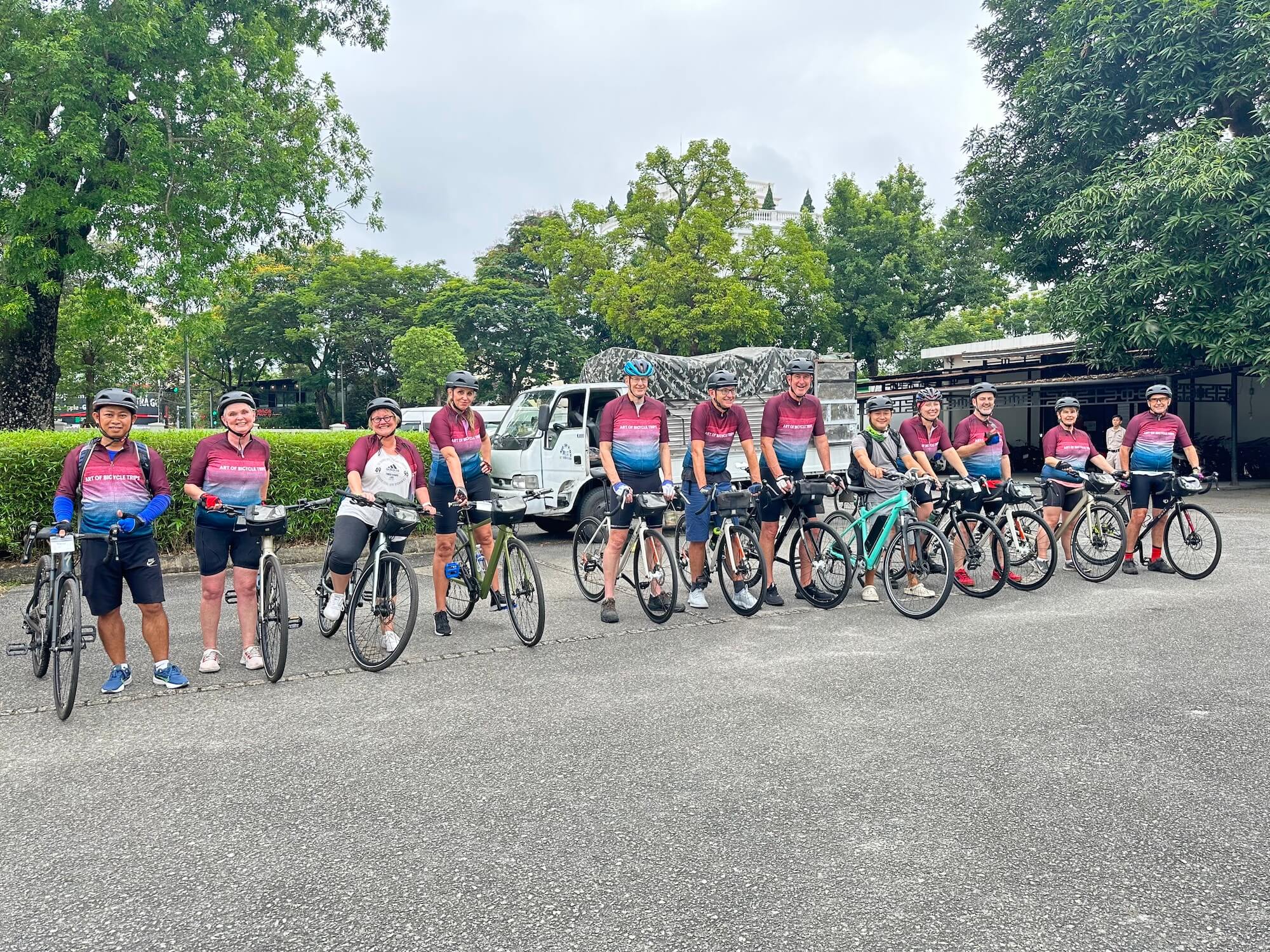Thoughtfully Crafted Bhutan Bike Tours and E-Bike Tours
Featuring boutique hotels and curated routes.

Explore Our Cycling Tours and Holidays in Bhutan
Reviews from our friends
Frequently Asked Questions
Our Best of Bhutan Bike Tour is an 8-day tour that starts at Thimphu, covers Punakha and the Phobjikha valley, and ends at Paro.
Our Bhutanese Dragon Bike Tour is a 14-day tour that covers three additional highlights — Trongsa, Bumthang Valley, and Haa Valley — that are off the beaten track.
Trongsa is home to the the largest fortified monastery in Bhutan, Bumthang is home to temples dating back to the 7th century AD, while the Haa Valley is one of the remotest valleys in Bhutan with excellent views of the 7326m (24,035ft) high Mt. Jomolhari, the source of the Paro river.
The best time for cycling in Bhutan is Spring (March to May) and Fall (September to November). The temperature during this time varies from 15 to 26 °C (59.0 to 78.8 °F). Days are bright and sunny, with little rainfall.
The best cycling in Bhutan happens in central Bhutan along a spine-like axis running in an east-west direction. Northern Bhutan consists of high mountains that are mostly inaccessible, whereas southern Bhutan is covered in large parts by protected forests.
The main areas of interest on this cycling route include:
Thimphu: Thimphu is the capital of Bhutan and its most vibrant city. Located at an altitude of 2,300m (7,545ft), it offers both natural beauty as well as cultural experiences to visitors.
Paro: Paro is both the name of the city, and the valley in which it is located. The city sits at an altitude of 2,200m (7,200 ft) surrounded by mountain peaks as high as 5,500m (18,000 ft). It is home to Bhutan’s only international airport. Paro is also where the famous Tiger's Nest monastery is located. This is a highlight you certainly don't want to miss on your Bhutan bike tour.
Punakha: Punakha is a valley located at a much lower altitude of 1,200m (4,000ft) compared to the rest of central Bhutan. This, combined with the fact that it is located at the confluence of Bhutan’s two main rivers — Pho Chu and Mo Chu — makes it the heart of Bhutan’s rice cultivation regions. The famous Bhutanese red rice, a staple of much Bhutanese cuisine, is best grown in Punakha.
Phobjikha: Phobjikha is a vast valley located 3,000m (9,842 ft) above sea level that is best known for being the home of the migratory black necked cranes that come down from Tibet each year. The beautiful valley is a great place for witnessing other rare fauna, along with experiencing the traditional Bhutanese festival of Tshechu.
Bumthang Valley: Bumthang valley is located in eastern Bhutan and is situated at an average altitude of 2,500m (8,202 ft). The valley is known for its apple, honey, and wheat production. The main town in the valley is Jakar, which is also home to the only brewery in Bhutan which brews the country’s famous Red Panda wheat beer.
Haa Valley: Haa valley is tucked away in southwestern Bhutan at an altitude of 2670m ( 8,759 ft) and is one of the least visited parts of Bhutan. Most of the valley is covered with alpine forests. Yak rearing is the most common occupation of the people, and the valley is a great place to sample yak milk, butter, cheese, and meat.
1. Stunning Natural Beauty
70% of Bhutan is covered by forests. This is the second-highest percentage in the world, after Finland. Bhutan is also the world’s most mountainous country, with 98.8% of the country’s area being mountainous. And as if that was not enough, it is also the highest country in the world, with the average elevation being 3279m (10,760ft). In fact, the world’s highest unclimbed mountain is located in Bhutan. This mix of pristine forests, mountains, highland plateaus results in some of the most beautiful scenery you’ll experience anywhere in the world.
2. Wide Variety of Terrains
Bhutan’s geographical diversity has to be experienced to be believed. From the low-lying Dooar plains located close to sea level, the terrain rises suddenly and spectacularly to snow-capped peaks well over 7,000m in altitude. In between the mountains and the plains are highlands, meadows, valleys, and gorges criss-crossed by numerous rivers.
3. Practically No Traffic
Bhutan has a population of only about 7,50,000 inhabitants, with nearly 15% of this population concentrated in its capital city of Thimphu. This means that when you’re out in the countryside on a Bhutan bike tour and riding through quaint Bhutanese villages, you will encounter next to no traffic at all.
4. It Is the World’s Only Carbon Sink
Bhutan is the first and only carbon negative country in the world. It absorbs more carbon than it produces, in effect, making it a carbon sink — the only one of its kind in the entire world. This also means that it is one of the least polluted countries in the world. So when you’re biking in Bhutan, all you get to breathe is clean, crisp Himalayan air.
5. The Tiger’s Nest Monastery
You’ve no doubt seen pictures of the world famous Tiger’s Nest monastery, perched precariously atop a cliff. Now is the time to visit this man-made miracle located in Paro, Bhutan.
6. Gross National Happiness
You’ve heard of Gross Domestic Product (GDP), but have you heard of Gross National Happiness (GNH) ? Come to Bhutan and you’ll find out. Bhutan is the only country in the world that measures productivity in Gross National Happiness rather than in GDP. This is because Buddhism, Bhutan’s state religion, emphasizes that happiness extends beyond mere material possessions. This makes Bhutan one of the happiest countries in the world, even if it is not the richest.
7. Well-preserved Ancient Culture
Bhutanese don’t just preserve their culture, they enforce it among themselves. For instance, it is mandatory for every citizen to wear the national dress whenever they attend a government office, visit a religious place, or enter a judicial building. Preservation of the country’s cultural heritage is one of the four pillars of Gross National Happiness, the country’s guiding philosophy.
8. A Haven of Spirituality
Buddhism is not just the state religion, but has been a way of life in Bhutan for over 2 millennia. Everywhere you go, you will encounter beautiful monasteries and peacefully meditating monks. When cycling in Bhutan, it is hard not to feel a deep urge to connect with your own spiritual side.
9. Wildlife
Bhutan is a biodiversity hotspot which is home to some of the most critically endangered animals on earth including the red panda, the snow leopard, and the marmot. The Takin, also called gnu goat, is Bhutan's national animal. However, the animals cyclists are most likely to encounter on a Bhutan bike tour are the yak and the graceful black-necked cranes.
10. Food
Bhutanese cuisine is based largely on the nutritious red rice and yak’s milk cheese, as red rice is the only variety of rice that grows in high altitudes, while the yak is the only cattle that thrives in Bhutan’s cold climate. Make sure to try out Ema Datshi, Bhutan’s national dish which is a spicy stew made from hot chili peppers and yak’s milk cheese. Also when cycling in Bhutan, make sure to try the two most popular snacks in the country — momos (steamed dumplings eaten with a hot sauce) and thukpa (noodle soup). You will surely love them.
At Art of Bicycle Trips, we believe in experiential travel. Our tours combine cycling with cultural activities and nature exploration.
An average day on tour includes 4-5 hours of biking, with the rest of the day reserved for local experiences such as exploring local attractions, interacting with local communities, visiting monuments and museums, learning local crafts, trying local cuisine and more.
Each guided Bhutan bike tour is led by an expert trip leader who is also a local. For groups of more than 4 members, we have 2 trip leaders to take care of our guests. ABT trip leaders are a repository of local knowledge, routes, customs, cultures, and cuisines. By employing only local guides, we also help generate employment opportunities for local communities.
All hotels on tour are carefully chosen for their character, comfort, and cuisine, and each hotel becomes an experience in itself that guests can enjoy.
A support vehicle accompanies guests at all times, and if at any point a rider does not feel like biking any further, they can always load their bike and sit in the support van.
Our tours are all-inclusive, which means meals, permits, fees, transportation and other additional costs are included in the price of the trip, unless otherwise stated.
We pride ourselves on the degree of customization we provide on each tour, and are always happy to accommodate any special requests from our guests relating to the tour.
Due to the terrain and the altitude, we provide mountain bikes and e-bikes on our Bhutan bike tours. All our bikes are of the latest make, well-maintained and in excellent condition.
Bhutan is the most mountainous country in the world — over 98.8% of its area is covered by mountains of the Himalayan range. Gangkhar Puensum (7,570m/24,835 ft), the highest unclimbed mountain in the world, is in Bhutan.
Cyclists should be prepared for challenging climbs when cycling in Bhutan. We ride through several mountain passes situated above 3,000m (9,842 ft) above the sea level. However, e-bikes are available for all our Bhutan bike tours to make tackling climbs a little easier.
For a good Bhutan bike tour, you would need a minimum of 8 days. You can cover the main Bhutan highlights such as Thimphu, Paro, Punakha, and Phubjikha in 8 days. However, for the best Bhutan cycling experience, it is recommended that you set aside 14 days. This allows you to explore some of the most beautiful but little known places in Bhutan including Bumthang Valley, Haa Valley, and Trongsa.
Bhutan is among the most prosperous South Asian countries. By western standards, however, it is classified as a low income country, with an average per capita income of $ 3,491
Let's Start Planning!
Ready to ride Bhutan? Let's plan your perfect cycling adventure.

Just getting started?
Discover everything you need to know in our Bhutan cycling guide.



